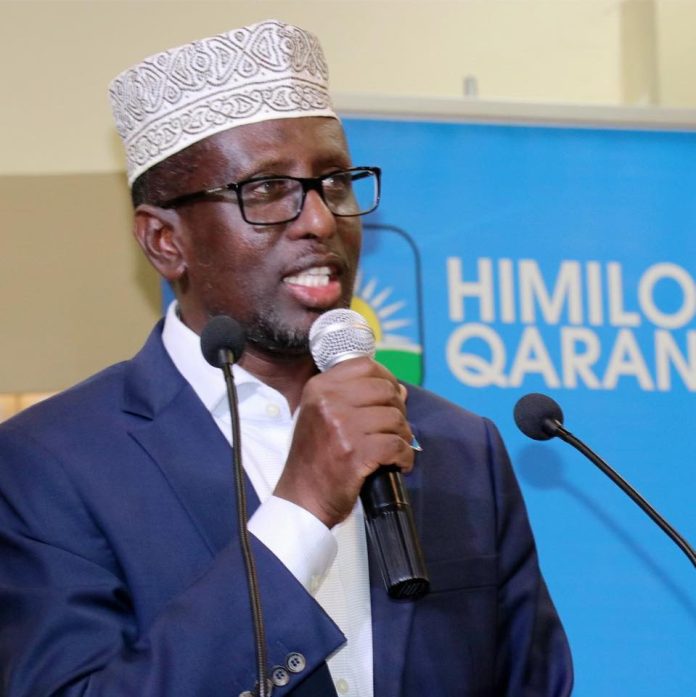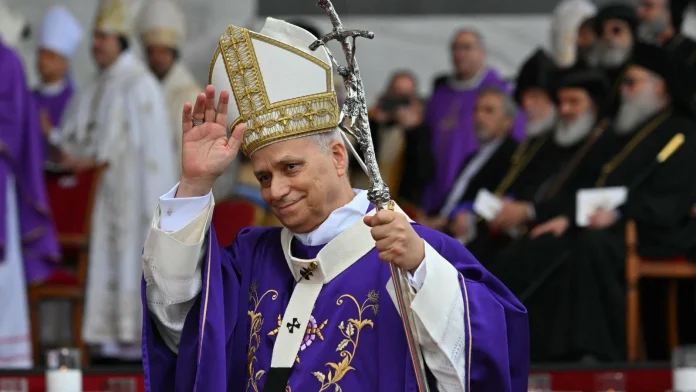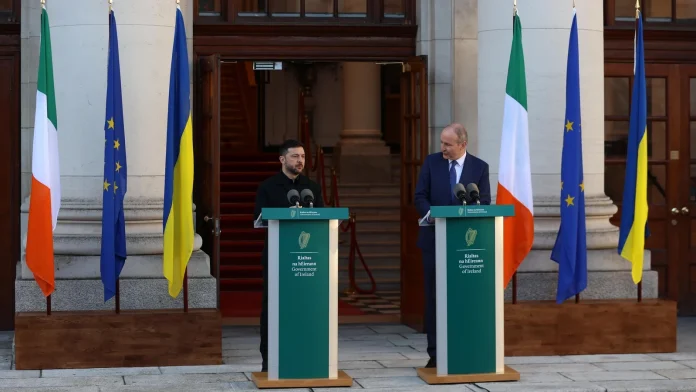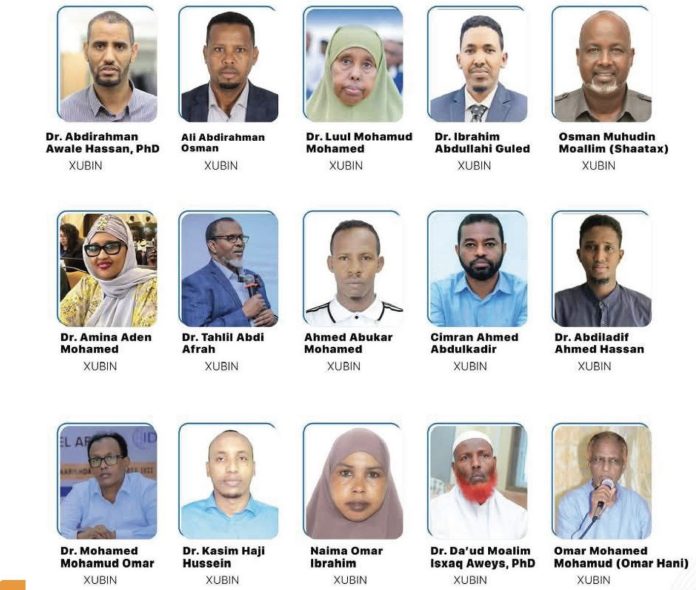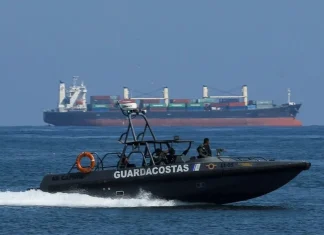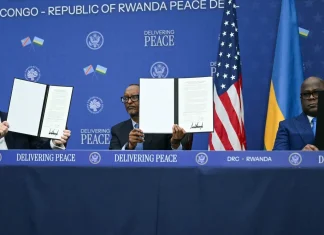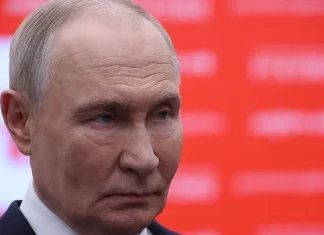Dec 03(Jowhar)-Xisbiga Madaxweyne Shekh Shariif ee Himilo Qaran ayaa kadigay boobka Xaafadaha saraakiisha Ciidanka ee Serandi,Shelare,Buula-wekiyo iyo Fardooley ee degmada Xamar-jajab.
Hong Kong leader orders independent inquiry into recent city fire
Hong Kong in Ashes: The Long Night After a Tower Blaze
There is a hush in the lanes around Wang Fuk Court that wasn’t there last week. Where markets once buzzed and old men played chess beneath flickering neon, the air now holds a bitter tang of smoke and the quieter, heavier smell of grief. Flowers pile up at cordons. Candles gutter in the wind. People who have never met exchange looks that say the same thing: this should not have happened.
Hong Kong’s deadliest fire in decades has left at least 156 people dead, about 30 still missing, and thousands displaced from a cluster of seven high-rise towers that together housed more than 4,000 residents. The numbers are brutal and blunt; they don’t capture the small stories — the mother clutching a charred shoe, a neighbour who carried an elderly man down six flights of stairs, the domestic worker who disappeared during a night shift.
What Went Wrong: Materials, Maintenance, and Missed Warnings
Investigators are pointing to renovation work as the spark that turned one building into an inferno. Samples of a green plastic mesh wrapped around bamboo scaffolding failed to meet fire-retardant standards, officials said, and insulation foam used in pockets of the work fed the flames. Authorities found that alarms in the complex were not functioning correctly. Contractors, according to senior officials, had placed substandard materials in hard-to-reach areas — effectively hiding them from routine inspections.
“The fire behaved like a living thing — it found the weakest seams in the building and ran,” said Eric Chan, the city’s Chief Secretary, at a press briefing. “Where materials were not up to standard, the consequences were catastrophic.”
Residents had warned about hazards more than a year ago. The Labour Department confirmed complaints from September 2024 about the potential flammability of the mesh. Officials responded at the time that the buildings faced “relatively low fire risks.” That judgment will now face the most intense scrutiny.
Fault Lines: Renovation, Regulation, and Responsibility
In a city built vertically, with narrow apartments and communal stairwells, the margin for error is slim. Hong Kong remains one of the world’s most densely populated cities, with about 7.4 million people packed into an urban landscape of towers and alleyways. That density makes mitigation and enforcement both vitally important and technically challenging.
John Lee, the Chief Executive, announced the creation of a judge-led independent committee to examine why the blaze started and spread so quickly — and to scrutinise the broader systems that allowed lethal materials to be used. “In order to avoid similar tragedies again, we will set up a judge-led independent committee to examine the cause and rapid spread of the fire and related issues,” he told reporters, pledging a transparent and thorough inquiry.
Yet transparency has been a flashpoint. Police have arrested 15 people on suspicion of manslaughter and the anti-corruption commission has detained 12 more in a probe into possible graft related to the renovations. It is unclear whether some individuals have been arrested on both counts. Rights groups warn that investigations should not become a pretext for muzzling criticism.
“Now is the time for authorities to show their work — to open the files, to explain the inspections and exemptions,” said Mei Wong, a local activist and former building inspector. “Silencing people who are asking questions will only deepen the wound.”
A City in Mourning: Faces Behind the Figures
Walk past the cordon and you see the human mosaic that made Wang Fuk Court more than a collection of floors: students studying late at a night table, grandmother shrines barely visible in the soot, migrant domestic workers who lived with families in the towers and now carry the same grief as everyone else. Among the dead are at least nine Indonesian domestic helpers and one worker from the Philippines — a stark reminder of the vulnerabilities shared by migrant communities who often live within the same walls as the families they care for.
“She called me in the morning and said there was smoke. I told her to get downstairs. She didn’t make it,” said Sari, an Indonesian woman who came to lay flowers, her voice breaking. “We work for others, but we are still family. Now we have lost sisters.”
Vigils have started to ripple beyond Hong Kong: similar gatherings are planned or already held in Tokyo, Taipei, and London, where the city’s diaspora has set up small altars with incense, notes, and yellow ribbons.
Rescue, Recovery, and the Long Tail of Displacement
Rescue teams have combed five of the seven buildings and will spend weeks on the remaining two, officials said, because these are the worst damaged. Images from inside — husk-blackened rooms, scorched furniture, safety suits and helmets reflected in broken glass — read like a catalogue of loss.
Nearly 1,500 evacuees have been rehoused into temporary housing, and another 945 placed in hostels and hotels. The government has offered an emergency grant of HK$10,000 (about €1,105) per household and expedited replacement of identity cards, passports and certificates for those who fled without documents. But money does not neatly buy back a life: keepsakes, photos, the smell of a home — all are irreplaceable.
“My grandchildren asked if our flats would ever be the same,” said Mr. Leung, a retired teacher whose third-floor home survived but who now sleeps at a relative’s flat. “There is a hole. You don’t heal by fixing plaster.”
Politics, Protest, and the Fragility of Public Space
This tragedy unfolds against a tense political backdrop. Beijing’s national security office warned against using the disaster to “plunge Hong Kong back into the chaos” of 2019 protests, and authorities have warned that any attempts to politicise the event will be “strictly punished.” A student and others have reportedly been detained on suspicion of sedition, stirring criticism from Amnesty International and Human Rights Watch, which have urged authorities not to silence legitimate questions about the cause and aftermath of the fire.
“When grief is politicised — or when politics is weaponised against grief — trust collapses,” said Dr. Hannah Ortiz, a sociologist focusing on civic trusts in urban Asia. “People want explanations. They want accountability. And when institutions answer with force, it deepens trauma.”
What This Means for Cities Everywhere
As the smoke clears, Hong Kong’s catastrophe forces questions that echo far beyond its harbour: How do we regulate the safety of quick renovation booms that pop up across dense cities? How are migrant and low-income residents disproportionately exposed to risk? And how do governments balance the need for swift action with the equally important need for transparent investigations?
Across Asia, from Tokyo to Manila, cities are wrestling with aging building stock, the pressure to refurbish rather than rebuild, and a materials supply chain that sometimes favours cost over safety. The tragedy at Wang Fuk Court is thus at once local and global: a horror rooted in a particular place, and a warning to urban planners, regulators and residents worldwide.
Remembering, Reforming, Reckoning
In the days ahead, the judge-led committee will begin its work. Families will demand answers. Volunteers will continue to sort through donations and offer counselling. The displaced will count their losses and try to stitch together a future in temporary rooms.
Will the inquiry lead to real change? Will officials hold those who cut corners accountable? Or will the story slip into the archive of tragedies that led to speeches and not reform?
For now, Hong Kong is a city sitting in the same uneasy silence as many other places that have lost lives to preventable disaster. It is a place of flowers, of numbers, of smoke, and of small human acts of kindness: a neighbour with a blanket, a volunteer handing out tea, a stranger who carries an elderly aunt down a stairwell. If the rest of us watch, let’s ask not just what happened, but what we will do to make sure it never happens again.
D.C. National Guard shooting suspect now faces murder charges

A Shot That Echoed to the White House: Grief, Fear and a Nation Reckoning
It was supposed to be another ordinary morning in the shadow of power — coffee cups, courier vans, joggers weaving through the iron fences that guard the president’s house. Instead, a single burst of violence turned Pennsylvania Avenue into a corridor of horror and questions that will not be easily answered.
On a block just blocks from the White House, two members of the US National Guard were ambushed. Twenty-year-old Private Sarah Beckstrom was killed. Private Andrew Wolfe, 24, remains hospitalized in critical condition. The suspect, identified in court filings as 29-year-old Rahmanullah Lakanwal, appeared remotely from a hospital bed this week as a judge ordered him held without bond on murder and other charges.
There is something jarring about violence so close to the symbols of American democracy — so close, literally, that the marble columns and dignified tourists now rub up against grief in a new way.
The court room that felt like a hospital room
Lakanwal’s first court appearance was not the polished, theatrical affair of criminal justice dramas. He appeared in a hospital gown, eyes half closed, the proceedings filtered through a translator who relayed the judge’s words in hushed sentences. Magistrate Judge Renee Raymond’s observation was blunt: “It is fairly clear that he came across the country, 3,000 miles, armed, with a specific purpose in mind.”
Prosecutors say he yelled “Allahu akbar!” as he opened fire — a claim that has since been part of charging documents that include first-degree murder and assault with intent to kill while armed. Defense counsel pointed to his lack of criminal history and urged release; the judge disagreed, citing the “sheer terror” of an attack so near the center of government.
In the moments after the shooting, accounts suggest the balance of fate shifted several times. A major in the Army National Guard reportedly fired at Lakanwal, and other service members alongside a Secret Service officer were credited with subduing him. In a city that rehearses security for state visits and protests alike, ordinary vigilance — and extraordinary courage — contained further harm.
Who was he, and how did he get here?
The man accused of carrying out the attack is an Afghan national who, according to federal filings, entered the United States in 2021 as part of the large evacuation and resettlement effort that followed the fall of Kabul. Hundreds of thousands of headlines and policy memos followed that moment, but no single image captures the complexity of what followed: families resettled across the nation, services strained, lives rebuilt.
“We welcomed roughly 70,000 to 80,000 Afghans in those months,” said Dr. Elena Cortez, a migration scholar who studies resettlement programs. “Some were Special Immigrant Visa recipients, some were paroled, but many came with trauma and urgent needs. We must not reduce entire communities to moments like this.”
That plea for nuance is not just academic. Around the country — in church basements, in municipal welcome centers, among volunteers who helped newcomers navigate school systems and jobs — people are struggling to reconcile two realities: grief for a slain soldier and the human story of people who helped the United States abroad and then sought refuge here.
“He came through my town before heading to DC,” said Josue Rivera, a volunteer with a resettlement group in Washington State. “I remember seeing him at the bus stop. He seemed quiet, always keeping to himself. This entire thing has shaken our shelter — we feel angry, we feel guilty, we feel confused.”
Politics and pain — a combustible mix
The shooting has been quickly folded into a broader and uglier national argument about immigration and security. Within hours, it became a talking point for politicians who insist on tighter borders and deeper scrutiny of refugee and parole programs. For others, the incident is a warning against scapegoating entire populations for the actions of one person.
Former President Donald Trump seized on the controversy and broadened it, turning from an Afghan suspect to denunciations of Somali immigrants — language that, for many, sounded more like a political crusade than reasoned policy debate. In a cabinet meeting reported by multiple outlets, Mr. Trump reportedly said, “Their country’s no good for a reason.”
His words landed like a blow in communities that have already felt the sting of suspicion. “We came here to build a life,” said Amina Warsame, a Somali-American shop owner in Minneapolis, where a separate scandal over fraudulent billing has recently roiled local politics. “To be told we don’t belong because of where we’re from — that’s personal.”
That scandal in Minnesota — prosecutors say more than $1 billion went to fictitious social services through fraudulent billing schemes — has been seized on by critics of immigration to suggest a correlation between newcomers and corruption. Experts caution against oversimplification: criminal networks exploit many vulnerabilities, and many fraud cases involve individuals across demographic groups.
Voices on the street
In downtown Washington, you can feel the tension in small things. A tour guide pauses when asked to explain the shooting to a group; a uniformed National Guard member adjusts her helmet and keeps walking. Neighbors leave flowers. People argue in cafes about whether the answer is more policing, more screening, or something quieter: more social care, better mental-health supports, and a public conversation less inclined to demonize.
“We saw a young woman in uniform, and then a part of us died,” said Michael Adler, a longtime Washington resident. “But we can’t convert grief into prejudice. That’s exactly what extremist narratives want.”
Immigration advocates point to longer-term facts: many Afghan evacuees were paroled for humanitarian reasons after helping US efforts in Afghanistan; many have since contributed to communities around the country. Meanwhile, national security experts warn that headline-driven policy changes can make the system less secure by driving people underground and reducing trust between immigrant communities and law enforcement.
What comes next?
The legal process will follow its course: arraignments, possible plea negotiations, and, if the case proceeds to trial, the painstaking work of uncovering motive, opportunity and state of mind. But beyond the court docket is the political and emotional adjudication that takes place in the public square.
How do we grieve without scapegoating? How do we keep places like Washington — where the ceremonial and the mundane sit cheek by jowl — both open and safe? Can policy respond to violence without feeding into narratives that degrade entire communities?
“This is a test of our civic muscles,” said Dr. Cortez. “We can respond with reflex and retribution, or we can respond with laws that are targeted, with community engagement, and with an insistence on facts over fear.”
For now, there are flowers, hospital monitors, and a nation watching as justice unfolds. There is also the quieter work of mourning a life ended too soon, and the harder work of ensuring that a single act does not become a verdict against millions.
As you read this, consider what kind of country you want to live in when the news headlines fade and the daily acts of neighborliness — teaching, cooking, driving the school bus — remain. Will we allow fear to define us, or will grief and resolve lead to policies that are both safer and more humane?
White House Declares Second Strike on Venezuelan Boat Lawful

At Sea and on Edge: How a “Double‑Tap” Strike Set Off a Storm in the Caribbean
Imagine dawn on the open sea: a thin pale light, the hum of engines, the salt tang in the air. Now imagine that tranquility ruptured not once but twice—first by gunfire and then, moments later, by a follow‑up assault on the survivors. That is the image seared into the narratives coming out of a recent US operation in Caribbean waters—a strike and a subsequent “double‑tap” attack that killed 11 people and helped push the death toll in a months‑long campaign against alleged drug traffickers to more than 80.
“We trained to hit a threat and move on,” said a retired Coast Guard intelligence officer who reviewed footage of the strikes. “But when you strike people who might already be incapacitated, you start stepping into territory that’s legally and morally fraught.”
What Happened: A Chronology
According to statements from the White House and reporting by US outlets, an initial strike on September 2 targeted a boat accused of smuggling drugs. Survivors of that attack were reportedly struck again in a follow‑on order. The White House has said that Admiral Frank Bradley, commander of US Special Operations Command, acted under the authority of Acting Defense Secretary Pete Hegseth in ordering the second, lethal engagement.
White House Press Secretary Karoline Leavitt told reporters that Admiral Bradley “worked well within his authority and the law directing the engagement to ensure the boat was destroyed and the threat to the United States of America was eliminated.”
President Donald Trump—who has framed the U.S. posture in the region as a fight against “narco‑terrorists”—later acknowledged the details in a brisk exchange with reporters aboard Air Force One, saying simply he “wouldn’t have wanted that — not a second strike.”
Numbers that Matter
Eleven people were killed in the two strikes tied to that operation; human rights advocates place the cumulative toll of this anti‑narcotics campaign at more than 80 dead over several months. Those figures have reopened a debate about what constitutes lawful use of force in maritime interdiction and whether lethal measures are being used against suspected traffickers at sea—not in court.
Voices from the Water and the Street
On the docks of a small Caribbean port, fishermen and residents reacted with a mixture of fear and weary resignation. “You don’t know when the next plane will come,” said Miguel, a 47‑year‑old fisherman, who asked that his surname not be used. “We’re not part of this, but every time the war comes to our waters, we lose a neighbor, a cousin.”
In Caracas, the strikes have been weaponized by President Nicolás Maduro’s government as proof, they say, that Washington is using the drug fight as a pretext for intervention. “They claim to be battling drugs while courting regime change,” a government spokesperson told a local radio station. Maduro himself has insisted publicly that Venezuela is a transit country, not a producer, and that the US rhetoric masks political aims.
Human rights groups—both local NGOs and international organizations—have been blunt. “The pattern suggests extrajudicial killings,” said a human rights lawyer in Bogotá who has tracked interdiction operations across the Caribbean. “There are legal frameworks that prohibit attacking shipwrecked persons. Orders to do so would be unlawful.”
Law, Policy and the Fog of War
The Pentagon’s own Law of War Manual is explicit in its prohibitions: firing upon shipwrecked individuals is described as clearly illegal. Yet US officials argue the strikes were lawful, framed under counter‑narcotics authorities and the broader concept of self‑defense against non‑state actors who, they say, pose direct threats.
“We have to weigh immediate danger to U.S. personnel and to Americans at home against the obligation to protect human life,” said a former military prosecutor based in Washington. “That balance isn’t always easy, and it’s precisely why lawyers are involved up and down the chain of command.”
Still, the optics are stark. In a conflict that sits somewhere between policing and war, the distinction between insurgent and civilian can blur quickly—especially at sea, where visibility is limited and evidence can slip beneath the waves.
Regional Ripples: Diplomacy, Tension, and an Uncertain Sky
Washington has also deployed heavy air and naval assets across the Caribbean, insisting they are dedicated to counter‑narcotics work. The presence of US carriers, surveillance aircraft and special operations platforms has, predictably, raised tensions with regional governments—most pronouncedly with Caracas.
President Trump raised the temperature further by suggesting that the airspace over and around Venezuela “should be considered closed in its entirety,” a comment that stirred anxiety in Caracas and among regional airlines. When pressed, he downplayed the remark. “Don’t read anything into it,” he said—while also confirming a phone call with President Maduro that left observers wondering whether belligerence and diplomacy are now being mixed in equal measure.
Broader Questions: The Drug War, Migration, and Human Costs
What does this moment tell us about modern counter‑narco policy? For one, it exposes a long‑running trend: the militarization of what was once primarily a law‑enforcement problem. Second, it raises uncomfortable questions about sovereignty, due process, and the global appetite for kinetic solutions to addiction, demand and organized crime.
And there are domestic reverberations. The same administration has also signalled sweeping changes to asylum and migration policy—announcing an indefinite pause on asylum decisions that critics say will exacerbate humanitarian suffering. “We’re trading legal process for expediency,” said an immigration advocate in Miami. “It’s a short‑term fix with long-term damage.”
What Should We Ask Next?
As readers watching from around the world, we must ask: what standards do democracies apply when they use lethal force beyond their borders? How do we protect human rights while confronting transnational threats? And who holds accountable those who authorize follow‑on strikes that leave survivors counting bodies, not answers?
These are not easy questions. They demand transparency from governments, a sober public debate about the limits of force, and a renewed commitment to international law. They also require humility: the sea is vast, and its dark waters do not always tell the whole story.
Closing Drift
Back onshore, Miguel casts his net with practiced hands. “We mend what we can,” he says, eyes on the horizon. “But some holes you can’t sew.”
That image—of torn nets and torn laws—may be the one that lingers. In the coming weeks, investigations, legal reviews and more reporting will either stitch those holes or leave them gaping. As the debate swells, we should all watch closely: for the lives lost, for the laws that protect us, and for the norms that govern how states use force in an interconnected world.
Brazilian beef recall renders existing safety safeguards redundant, officials say
A shipment, a recall and a country’s heartbeat: what the Brazilian beef scare reveals about trade, health and trust
It began with a routine scan through a cold chain and ended up reverberating through farms, kitchens and parliamentary corridors across Europe. Earlier this month, consignments of frozen beef from Brazil were flagged by European authorities after tests detected hormone residues that are banned in the EU. Supermarket shelves were emptied in a dozen countries; consumers were left with questions; farmers, furious, demanded answers. And in Ireland — where meat is not just an industry but an identity — the story took on a particular heat.
The recall that woke up a continent
Austria, Belgium, Cyprus, Croatia, the Czech Republic, Germany, Greece, Italy, the Netherlands and Slovakia all reported withdrawals or recalls. The United Kingdom — including Northern Ireland — also pulled affected products. The European Commission says the shipments came in earlier this month. Details are still being clarified, but the headline is simple and alarming: a banned growth-promoting substance found in meat that has already crossed oceans and borders.
“If any product that ends up on Irish plates may contain substances we outlaw for public health reasons, that’s not just a compliance question — it’s an emergency of trust,” said a representative of a national farmers’ group I spoke with in a rain-dampened yard in County Mayo. He asked not to be named; his hands still bore the smell of silage and diesel.
Farmers fear competition — and contamination
On country roads and in village pubs across rural Ireland, the recall resonated like a bell. For years, Irish farmers have argued that the Mercosur trade deal—an agreement under negotiation between the EU and the South American bloc of Argentina, Brazil, Paraguay and Uruguay—threatens prices and livelihoods by opening the EU market to cheaper meat.
“It’s not just the price,” said Maeve Ní Dhúill, who runs a small dairy and beef farm near Killarney. “It’s the principle. We invest in traceability, veterinary records, animal welfare. We take pride in that. If cheaper meat, produced under different rules, floods the market and then comes with health questions, who bears the cost? The farmer does. The consumer does.”
For context, the proposed Mercosur beef tariff quota would allow up to 99,000 tonnes of beef to enter the EU at a reduced tariff (reportedly around 7.5%). For poultry the figure discussed has been as high as 180,000 tonnes. These numbers may sound technical, but for a small island economy with a strong beef and dairy sector, they translate into real anxieties about incomes and markets.
Politics on the pitch: who says what?
The recall landed at an awkward time politically. Calls grew for clarity from Ireland’s leaders. “We need the Tánaiste and our party leaders to spell out where they stand — now,” a union official told me in Dublin. “This isn’t abstract. This is our food, our farms, our children’s lunches.”
Not everybody sees the moment in apocalyptic terms. “Mercosur isn’t solely about beef,” said an MEP with links to Ireland’s centre-right who believes trade can broaden opportunities. “These are economies of 250–270 million people. There are sectors — pharmaceuticals, machinery, medical devices, dairy — that stand to gain from deeper access. Trade deals have winners and losers; the job is to manage both.”
That tension — protection of sensitive domestic sectors versus the promise of export growth — is the political drumbeat of this debate. It crosses party lines and stirs public emotion. In local cafes I visited, people spoke of pride in Irish standards and unease about invisible risks: antibiotic resistance, hormone residues, and a perceived erosion of regulatory certainty.
Science, safety and gaps in oversight
Public health specialists point out two overlapping issues: the immediate risk of banned substances entering the food chain, and the long-term erosion of confidence in supply chain controls. “The European Union’s rules on growth promoters are strict for good reasons,” said Dr. Aoife Brennan, a food safety scientist at a university in Cork. “When those rules are breached it raises two questions: how did it get through the pre-export checks, and is our detection and recall infrastructure fast enough to protect consumers?”
Dr. Brennan noted that no food system is flawless. “Inspection regimes rely on sampling, documentation and on-the-ground traceability. If any one of those pillars fails, contamination can slip through. The fact that these consignments were identified and recalled is evidence our system can act. The fact that they entered at all suggests the system is imperfect.”
Local color: markets, pubs and the smell of stews
Walk into any Irish market and you’ll see posters of cattle breeds, families trading recipes, and butchers who can name the field a cut came from. “We like to know where our meat comes from,” said Seán, a third-generation butcher in Limerick. “Customers ask me if the beef was raised in clean pastures, if it was fed properly. That’s part of the trust we sell.”
That trust is not only economic. It’s cultural. Roasts for Sunday dinner, stews shared at funerals, and the bargaining of calves at mart—all are threaded through generations. For many, the Mercosur debate thus feels like something that could alter more than ledgers: it could reshape a way of life.
What’s at stake beyond the steak
Ask yourself: do you want a world in which standards are lowered to win market share, or one in which trade is accompanied by enforceable standards and transparency? This is the moral and political question underpinning the row.
Environmentalists add another layer. Deforestation in parts of South America, linked to cattle ranching, has been a long-standing worry. “A trade deal that increases demand for beef without binding environmental and social clauses risks encouraging practices at odds with EU climate goals,” said an adviser from a European environmental NGO.
Where do we go from here?
The immediate step is clear: tighten controls, review how consignments were cleared, and ensure swift recalls when problems are identified. Politically, negotiators must reconcile two truths: trade can lift industries, but it cannot be at the cost of public health or fair competition.
For farmers, the fix will require more than reassurances. “Words won’t fill a bank account,” one farmer in County Cork told me. “We need measurable protections: enforceable quotas, stronger on-site checks in export countries, and penalties that stick.”
Questions to ponder
- How can importing and exporting countries build mutual trust without sacrificing consumer safety?
- Should food products be carved out of broader trade deals if risk profiles differ so sharply?
- And finally: what price are we willing to pay for cheaper food if it erodes the standards many of us take for granted?
The recall of Brazilian beef is more than a supply-chain hiccup. It is a live demonstration of the frictions that arise when global trade rubs against local norms, public health and environmental concerns. It has set politicians, farmers and food-safety experts against one another in a debate that will shape policy and plates for years to come.
Whatever your view of trade deals, take a moment next time you sit down to a meal: consider the journey your food made to get there. Behind every steak, every carton of milk, there is a chain of decisions — political, economic and ethical. The present controversy asks us to scrutinize those choices with urgency and care.
Pope Appeals to Lebanese Crowds to Heal Their Crisis-Hit Nation
Beirut at Dawn: A Pope, a City, and a Fragile Hope
The Mediterranean sun had barely cleared the skyline when the waterfront of Beirut came alive with flags, umbrellas and a kind of brittle joy that only a city accustomed to survival can display.
It was not just any crowd. Tens of thousands—Vatican figures put the number at 150,000—had gathered where modern glass meets Ottoman stone to hear Pope Leo XIV, the first American elected to the papacy, deliver what felt less like a homily and more like a plea: for unity, for justice, for a country that can remember its better angels.
“Cast off the armour of our ethnic and political divisions,” he implored, voice steady under the hot sky. “We must unite our efforts so that this land can return to its glory.”
Scenes from the Waterfront
Students, shopkeepers, priests in cassocks and pensioners in sun hats clustered along the esplanade. They waved tiny Vatican and Lebanese flags in the same palm as their phones. Men and women shielded themselves from the strong Mediterranean light with umbrellas that fluttered like small sails.
“We came before dawn,” said Maroun al‑Mallah, a university volunteer with a tired, hopeful smile. “You can feel it’s a reset. Even if it’s a small one. We’ve had pain after pain—especially after the port blast. Today felt like the city was saying, ‘Maybe we can breathe again.'”
The scene was cinematic: the pope touring the crowd in an enclosed popemobile, stopping to bless, to nod, to meet faces lined with history. The spectacle masked the deeper, quieter weight that every Lebanese soul carried—grief, anger, and an almost scientific exhaustion at promises unkept.
At the Edge of Rubble: Memory and Demand for Justice
Hours before the mass, Pope Leo paused at the scar of Beirut’s 2020 port explosion, laying a wreath at a memorial where photographs of the dead fluttered in the wind. The blast, which killed more than 200 people and caused billions of dollars in damage, still sits in the national consciousness like an unhealed wound.
He walked slowly among survivors and relatives from different faiths, greeting them and offering rosaries tucked in pouches embossed with his coat of arms. A woman who lost her brother reached out to embrace him; she sobbed. He embraced her back.
“He will raise his voice for justice, and we need justice for all the victims,” said Cecile Roukoz, who holds a photograph of her brother like a small, stubborn lantern. “We need someone to say we will not forget.”
When Faith Meets Accountability
The pope’s gesture at the blast site carried symbolic weight. Investigations into the explosion have been repeatedly delayed or obstructed, and no one has been held accountable. For many Lebanese, ritual without remedy feels like salt in an old wound.
“Faith can comfort, but faith cannot replace the work of institutions,” said Dr. Leila Haddad, a Beirut‑based political scientist. “Religious leaders can convene a conversation across sectarian lines, but the hard, technocratic steps—justice, reforms, rebuilding—must follow. Otherwise, this momentum fizzles.”
Lebanon’s Intertwined Crises
It is impossible to paint the pope’s visit without tracing the tangle of crises that brought Lebanon to this moment. The country hosts roughly around a million Syrian and Palestinian refugees, a demographic pressure that has strained public services. Since late 2019, Lebanon has endured a dramatic economic collapse: the local currency has lost much of its value, unemployment has soared, and a large proportion of families now live in multidimensional poverty, measured not just by income but by access to health, education and basic utilities.
Then add the spillover of regional conflict. Last year’s intense exchanges between Israel and the Iran‑aligned Hezbollah left neighborhoods shattered and nerves raw. The threat of renewed hostilities hangs like a low, constant thunder.
- 2020 Beirut port explosion: over 200 fatalities and billions in damages (official estimates vary)
- Refugee presence: approximately one million Syrian and Palestinian refugees in Lebanon, placing strain on infrastructure
- Economic collapse: currency depreciation and widespread poverty since late 2019 with long‑lasting social effects
Voices on the Ground
“People ask, ‘What can one visit change?’” said Father Georges Nassar, a Maronite priest whose parish sits in a neighborhood scarred by the explosion. “Change isn’t instant. But when a global religious leader kneels where we knelt and names what’s wrong—corruption, impunity, division—it validates our grief and puts pressure on those who govern.”
“This place has long been a mosaic of religions,” said Nour al‑Amin, a teacher who keeps a small icon in her classroom. “We are Christians, Muslims, Druze. But that diversity has been used as a political lockbox. Can faith free us from that lock? Maybe. But faith has to be paired with courage from politicians and accountability from institutions.”
Experts Weigh In
“Religious leadership can act as a bridge in fragmented societies,” said Dr. Michael Turner, an expert in conflict resolution at an international think tank. “But bridge building must be followed by structural investment—transparent courts, functioning public services, and economic opportunity. Without those, the bridge becomes a spectacle, not a pathway.”
Beyond Beirut: A Mirror for Fragile States
Lebanon’s story resonates well beyond its shores. It is a compact case study of how climate, conflict, economic mismanagement and displacement can conspire to hollow out a country’s institutions. It is a cautionary tale and, to others, a call to empathy.
How do societies stitch themselves back together after trauma? Can religious figures catalyze political redemption? In an age where populism and sectarian politics are surging in many parts of the world, Lebanon asks a question we all must answer: what do we owe each other when the systems we trusted fail?
The pope’s visit did not produce policy roadmaps or immediate indictments. It produced something quieter, and perhaps more crucial: a public naming of pain, a shared mourning, and, for a moment, a crowd that believed—just for a day—that unity was possible.
What Comes Next?
After the crowds dispersed and the last flags were folded, Beirut settled back into the difficult business of daily life. The port’s ruins remain, the economy still teeters, and political rivalries endure. But the visit left behind small sparks: survivors who felt seen, volunteers who felt emboldened, politicians gently nudged by the optics of global attention.
Will those sparks catch? Can rhetoric be translated into reform? Those are questions that will be answered in months and years, in courts and parliaments, in hospital wards and classrooms.
As you read this from wherever you are—city, suburb, or island—ask yourself: when a nation asks for unity, what does solidarity mean in practice? How do you show up? Lebanon’s story is an invitation to consider the hard work of rebuilding trust, brick by brick, prayer by policy.
For now, the memory endures: a waterfront awash in flags, the pope’s steady voice, a woman’s desperate embrace, and a city that refuses to let go of hope. That, perhaps, is the most human thing of all.
Zelensky: There’s a Real Opportunity Now to End the War
I’m ready to reimagine this into a vivid, 800+ word blog piece in a human voice with rich detail, quotes, stats and WordPress-ready HTML — but I don’t actually have the full news content you want rewritten. Could you paste the article or key text here (or give a link)?
Mangione appears in court at suppression hearing seeking to block evidence

The Man Outside the Midtown Hotel: A Trial That Feels Bigger Than a Crime
On a crisp Manhattan morning, the courthouse at 100 Centre Street hummed like the city itself — part rumor mill, part solemn temple of law. Under a bank of fluorescent lights and just beyond the metal detectors, Luigi Mangione, 27, sat at the defense table in a gray suit patterned with the kind of nondescript care that seems designed to disappear into a crowded room. He said nothing as officers unlatched his handcuffs and the day’s hearings began — hearings that may decide whether crucial pieces of evidence make it to a jury next year.
The charge that brought him here is stark and terrible: the fatal shooting of a UnitedHealthcare executive, Brian Thompson, on a Midtown sidewalk. Mangione was arrested in December 2024 at a McDonald’s in Pennsylvania, recognized from news photos, and accused of a crime that reverberated well beyond the narrow sidewalk where it occurred.
Not just a courtroom drama
This is not only a case about a single act of violence; it’s a flashpoint where anger about health care, the mechanics of policing, and the scope of criminal procedure collide. Outside the courthouse on the first day of hearings, a small crowd had gathered: one demonstrator in a Super Mario Bros. villain costume held a sign reading “When patients die, profits rise,” while a woman wearing a sash that said “Free Luigi” moved through the throng handing out pamphlets. What looked like a carnival tableau underscored something darker — a nation’s simmering frustration about access to care, skyrocketing premiums, and the personal toll of a system many feel is broken.
“People are desperate,” said Maria Gutierrez, a nurse from Queens who came to watch the proceedings. “They see people making billions while their neighbors choose between insulin and rent. It doesn’t excuse violence, but it helps you understand why someone might snap.”
What’s at stake in these hearings
In the next few days, before Judge Gregory Carro, lawyers will argue over the admissibility of what prosecutors say was found in Mangione’s backpack when he was arrested, and whether statements he made while in custody should be used at trial. The items in question — an allegedly 3D-printed firearm, a silencer, electronic devices and journal pages — are the prosecution’s narrative threads tying a suspect to a deed. The defense counters that the search violated Mangione’s rights and that any statements were taken without proper Miranda warnings.
“This is not about clever legal maneuvers; this is about constitutional guardrails,” said Daniel Rios, a defense attorney watching the courtroom. “If the police can circumvent these rules, every weak link in the system becomes a crack in the foundation.”
Arrest in a Pennsylvania McDonald’s
The arrest that followed the shooting reads like a piece of American folklore. Surveillance footage — played in court by a security camera technician — places Mangione inside a McDonald’s in Pennsylvania, eating and waiting, until someone in the restaurant recognized him from the news and alerted authorities. There is a cinematic logic to it: a man brought down not by detectives in a sting, but by the glare of coverage and the watchful eyes of strangers.
Yet even as a prosecutor prepares to stitch the evidence together, defense lawyers insist procedural defects tainted the whole tapestry. At stake in these pretrial hearings is whether the case proceeds with the prosecution’s strongest threads, or whether a jury will see a different picture altogether.
Charges and possible punishments
The scope of the legal jeopardy is substantial. If convicted of murder in the second degree — an intentional killing under New York law — Mangione could face life in prison. He also faces several weapon possession counts and a charge for possessing false identification. In a separate federal case, where prosecutors have signaled an intention to seek the death penalty, he has pleaded not guilty. Trial dates have not been set in either matter.
- Murder in the second degree — potential life sentence
- Multiple counts of criminal possession of a weapon
- Possession of false identification
- Separate federal case where the death penalty has been floated by prosecutors
When terror charges were ruled out
Not every arrow in the prosecutor’s quiver stuck. In September, Judge Carro dismissed two terrorism-related counts, finding insufficient evidence that Mangione intended to intimidate health insurance workers or influence government policy. That ruling narrowed the narrative: what remains is framed as a personal and criminal act rather than an explicitly political one.
“That decision reflected the law’s careful boundaries,” said Professor Leah Huang, a constitutional law scholar. “Terrorism counts carry an enormous label. Courts are right to demand clear proof that someone meant to send a political message, not merely to commit a violent act.”
The larger canvas: health care, anger, and a country’s fissures
To appreciate why the case generated headlines and, for some, martyrdom, you have to step back and see the larger American landscape. The United States spends more on health care than any other nation — roughly 18% of GDP in recent years — and per-person expenditures are far higher than in other wealthy democracies. Insurer power and the opaque calculus of premiums and denials have created a climate where frustration sometimes metastasizes into outrage.
“This is not simply about one man and one gun,” said Dr. Amina Farouk, a public health researcher. “It’s about a social contract that many feel is broken. When systems feel indifferent to suffering, some people look for catharsis in extreme ways.”
What a trial could reveal — and what it may not
Courtrooms are blunt instruments for truth: slow, meticulous, rhythmically procedural. They will parse the nuts and bolts of arrest procedure, forensic evidence, and chain-of-custody. They will not, however, settle the broader questions this case touches. They won’t fix a health care system where millions are underinsured, nor will they heal families bereft. What they will do is hold individuals accountable under the law.
As the hearings continue, you might ask yourself: what does justice look like in an era of structural grievance? Can the legal system address individual culpability while also illuminating systemic failure? And if a courtroom focuses our attention briefly on a broken system, who will carry forward the work of repair?
Outside the courthouse, a woman with a “Free Luigi” sash folds a pamphlet into a pocket. A man in a Mario-esque costume argues with a passerby about profits and lives. Inside, lawyers haggle over the admissibility of journal entries and a 3D-printed object. The city, as always, keeps moving — indifferent and intimate, brutal and brilliant.
What happens next will be measured in legal briefs and rulings; in the meantime, the case stands as a mirror. It reflects not just a sliver of criminal conduct but a broader national conversation about rage, responsibility, and the systems that shape both.
Kooxo Hubeysan oo Askari NISA ah ku dishay Magaalada Muqdisho
Dec 02(Jowhar)-Kooxo hubeysan ayaa maanta dil u geysatay Cumar Kalaxay, oo ahaa askari dharcad ah oo ka tirsanaa Ciidanka Nabad Sugidda iyo Sirdoonka Qaranka (NISA). Falka dilka ah ayaa ka dhacay isbaaradii hore ee Saruurka, oo ku taalla degmada Heliwaa ee gobolka Banaadir.
Wasaaradda Caafimaadka oo Magacaawday Xubnaha Golaha Mihnadlayaasha Caafimaadka Qaranka
Dec 02(Jowhar)-Wasaaradda Caafimaadka iyo Daryeelka Bulshada ayaa maanta shaacisay magacaabista 15 xubnood oo ka mid noqonaya Golaha Mihnadlayaasha Caafimaadka Qaranka (GMQ).


